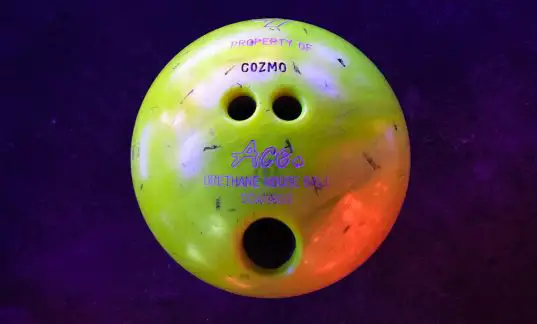From finger holes to their cores, today’s bowling balls are wonders of modern sport technology. When you purchase your own ball and get your ball drilled for your fingers, you’re augmenting a piece of impressive tactile tech that’s built with pure performance in mind.
Whether you’re a member of the United States Bowling Congress or a newbie to the game, it pays to understand what goes into the bowling balls you play with. From the smooth surface of plastic balls to the rougher coverstock of reactive resin offerings, modern bowling balls have plenty of moving parts that work together to help you maximize your scoring potential.
What are modern bowling balls made of?
Plastic/Polyester Bowling Balls
If you’ve ever used a house ball before, you’re likely familiar with how plastic balls work. Often coupled with symmetrical cores and weight blocks perfect for spare shooting and straight-line throwing, plastic bowling balls often cost less and require less maintenance than their high-performance counterparts.
Often used as spare balls by top bowlers around the world, plastic balls are usually made of non-porous polyurethane. Using plastic symmetrical balls is a great idea when you’re trying to pick up a single pin and don’t need a creative entry angle towards the pin deck. Many bowling balls with plastic coverstocks struggle with deeper oil but do well in medium-dry conditions or when lane patterns start to deplete.
Core shapes differ with plastic bowling balls, regardless of whether they’re house balls or otherwise. However, polyester balls are mostly built for consistency and accuracy instead of reactivity.
Reactive Resin Balls
The majority of high-performance bowling balls made for use by an intermediate or advanced bowler are covered with reactive resin coverstocks. Bowling ball manufacturers work tirelessly to augment their tactile coverstock technologies to meet the demands of serious bowlers around the world. Three major types of reactive resin balls available give competitive bowlers different options in terms of ball motion, weight block shape, surface hardness, surface roughness, and other unique bowling ball specifications. They are as follows:
- Reactive Solid Bowling Balls
- Reactive Hybrid Bowling Balls
- Reactive Pearl Bowling Balls
Each of these three reactive resin bowling ball types attacks a bowling lane surface differently. However, they all offer reactivity and hook potential lacking in other types of ball coverstocks. A reactive resin ball’s motion is informed by its porousness and ability to absorb oil during a shot. This oil absorption can add angularity to a ball hook, sudden shifts of direction at the breakpoint, and mid-lane traction.
A reactive resin bowling ball’s surface has a base of advanced polyurethane, treated with special compounds that promote everything from increased friction to aggressive ball movement at the breakpoint. Modern balls with reactive resin coverstocks have far surpassed older balls when it comes to tackling the wettest and most complex of lane conditions. And coupled with advancements in the shaping and construction of bowling ball cores, reactive resin balls are the new darlings of ten-pin bowling around the world.
Urethane Bowling Balls
Before the introduction of reactive resin balls to the bowling world, there was the urethane ball — the perfect graduation ball for those looking to move away from plastic bowling balls. Promising more friction and wilder hooks than a plastic ball, the coverstock material of a urethane bowling ball is made to dip into medium oil with gusto.
The urethane compounds used for a urethane ball’s coverstock don’t offer the same reactivity as reactive resin compounds. When you buy a new bowling ball with a urethane coverstock, you’re sacrificing hook angularity and violence compared to a reactive resin option. However, you can attack bowling pins with a consistent hooking motion augmented by whatever core shape is under the hood.
Not as popular at bowling alleys nowadays as they were in the 1980s, urethane bowling balls are still a great idea for bowlers who want a more muted hook potential.
What is a modern bowling ball core made of?
The outer core and coverstock of a bowling ball don’t compare in heaviness to the materials used to make a ball’s core. Heavy balls are mostly weighed down by the compounds used to create the core.
Bowling ball cores are often made of powdered metal oxides hardened with both a catalyst and plenty of resin. Popular metal oxides used to create bowling ball cores include iron, barium, bismuth graphite, and calcium. If you purchase a ball weighing 15 pounds, much of that weight is attributed to the core itself.
What are modern-day bowling balls filled with?
Often referred to as the outer core of a bowling ball, the filler material underneath a bowling ball’s coverstock and surrounding the inner core varies in composition. Kids’ bowling balls use lower-density fillers to keep the weight down. Heavier bowling balls use higher-density compounds.
The filler within a bowling ball usually consists of pieces of polyester mixed with resin or glass beads. These filling materials are calibrated perfectly to augment the weight and protect the inner core from harm (while keeping it in place.)
What other types of bowling balls are there and what are they made of?
Rubber Bowling Ball
Before the introduction of the plastic bowling ball, rubber bowling balls ruled the bowling world. Made of galvanized rubber and lacking the technological advancements of modern-day bowling balls, rubber balls were made of galvanized rubber with no oil absorption properties.
Candlepin Bowling Ball
Candlepin bowling balls lack finger holes and are often as small as the palm of your hand. They are made of wood, plastic, rubber, or a compound of those materials.
Duckpin Bowling Ball
A little bit bigger than a candlepin bowling ball, duckpin balls also eschew the finger holes of their ten-pin counterparts. They are very similar to five-pin bowling balls and are often made of a compound of synthetic materials and rubber.
Lawn Bowling Ball
When lawn bowling first hit the scene many centuries ago, stone balls and stone pins were not uncommon. Nowadays, lawn bowling balls are often made of hard composite plastic.
Frequently Asked Questions
Do bowling balls float?
It depends on the weight of the bowling ball. If your bowling ball is under 12 pounds with finger inserts and other accouterments factored in, it will float. That’s because they have a density of under 1 g/mL. Bowling balls that are labeled at 12 pounds exactly might float, sink, or hover a bit in the water. And, bowling balls over 12 pounds will simply sink.
Are urethane balls good for throwing strikes?
The answer to this question has a lot to do with how you best throw strikes. If you’re looking for wild angularity and creative entry positions towards the pin pocket, you should opt for a reactive resin ball instead of a urethane one. However, those looking for smoother hooks and more consistency in medium oil might prefer urethane for their strike ball.
Should you use different types of balls on different bowling lanes?
Yes. When lane conditions are dry and oil is scarce, some reactive resin bowling balls end up being much more trouble than they are worth. Be mindful of the oil patterns at your bowling alley and how different types of bowling balls are being affected. If you have a urethane or plastic ball in your bag, use it when lane conditions are sub-optimal and a reactive ball just isn’t cutting it.
Closing Thoughts
Whether you’re a fan of the friction created by reactive resin bowling balls or the smoothness of plastic offerings, knowing what goes into your ball will help you pick the right option at the right time. Bowling balls may look simple, but they’re not. A lot is going on, both on the surface and underneath it.


